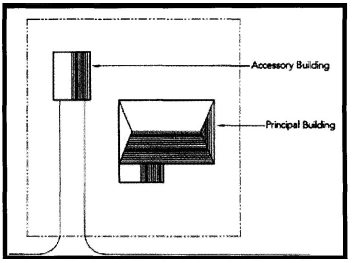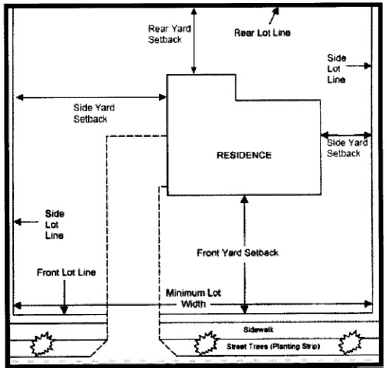For the purpose of this chapter, the following definitions shall apply, unless the context clearly indicates or requires a different meaning.
ACCESSORY BUILDINGS. Any building except the principal building on a lot. In the case of a house and detached garage on a lot, the accessory building is the garage. Examples of accessory structures are detached garages, carports, playhouses, sheds, private greenhouses, gazebos, storage buildings, wind generating devices, swimming pool, and radio and television receiving antenna towers and dishes, etc.
ACCESSORY BUILDINGS. Any building except the principal building on a lot. In the case of a house and detached garage on a lot, the accessory building is the garage. Examples of accessory structures are detached garages, carports, playhouses, sheds, private greenhouses, gazebos, storage buildings, wind generating devices, swimming pool, and radio and television receiving antenna towers and dishes, etc.

ALLEY. A street or thoroughfare less than 21 feet wide and generally affording only secondary access to abutting properties.
BASEMENT. A story partly underground, which, if occupied for living purposes, shall be counted as a story for purposes of height measurements.
BOARDING HOUSE. A building other than a hotel where meals or lodging and meals are furnished for compensation for three or more persons not members of a family.
BUILDING. Any structure used, designed, or intended for the protection, shelter, enclosure, or support of persons, animals, or property.
BUILDING HEIGHT. The vertical distance from the top of the building roof to the average elevation at the front property line.
DWELLING, MULTIPLE-FAMILY. A building or portion thereof designed for, and occupied by, three or more families.
DWELLING, SINGLE-FAMILY. A detached building designed for, or occupied exclusively by, one family.
DWELLING, TWO-FAMILY. A detached or semi-detached building designed for or occupied exclusively by two families.
FAMILY. One or more persons living, sleeping, cooking and eating on the same premises as a single housekeeping unit.
FLOOR AREA. The combined area of all floor levels within the exterior walls of a building, which is unusable as living quarters except basement levels unless one or more walls are completely exposed as walk out area.
GARAGE, ATTACHED. A structure for the primary purpose of storing motor vehicles, which is connected to the principal structure by a common wall.
GARAGE, DETACHED. A structure for the primary purpose of storing motor vehicles, and is free standing from the principal building. A detached garage is considered an accessory structure.
GARAGE, PRIVATE. An accessory building or space for the storage only of not more than two motor-driven vehicles per dwelling.
GARAGE, PUBLIC. Any building or premises, other than a private or storage garage, where motor-driven vehicles are equipped, repaired, services, hired, sold or stored.
GARAGE, STORAGE. Any building or premises used for storage where no sales or services are rendered.
HOME OCCUPATION, CUSTOMARY. A business, profession, trade or employment conducted in a person's dwelling which may involve that person's immediate family or household and a maximum of one other person, and which does not generally require patrons or customers to come to the dwelling on a regular or semi-regular basis. Examples of home occupations include, but are not limited to, the following: home offices, "telecommuting", wholesaling by phone or by mail, Internet publishing and web page design, medical transcription, child care limited to three children, etc. Home occupations do not include any business involving explosives, fireworks, painting or repair of motor vehicles or small engines, catering services, kennels, restaurant or tourist home. See also “home occupation, intensive”.
HOME OCCUPATION, INTENSIVE. A business, profession, trade or employment conducted in a person's dwelling which may involve that person's immediate family or household and a maximum of two other persons, and which by nature requires patrons or customers to come to the dwelling on a regular or semi-regular basis. Examples of intensive home occupations include, but are not limited to, the following: Hair, nail, or beauty salons, photography studios, tailoring and alterations, etc. Intensive home occupations do not include any business involving explosives, fireworks, painting or repair of motor vehicles or small engines, catering services, kennels, restaurant or tourist home. See also “home occupation, customary”.
HOTEL-MOTEL. A building in which lodging, with or without meals, is offered to transient guests for compensation and in which there are more than five sleeping rooms with no cooking facilities in any individual room or apartment.
JUNK YARD. A lot, land or structure, or part thereof, used for the collecting, storage or sale of waster paper, rags, scrap metal or discarded material; or for the collecting, dismantling, storage or salvaging of machinery or vehicles not in running condition or for the sale of parts thereof.
LODGING HOUSE. A building other than a hotel where lodging only is provided for compensation for not more than 12 persons not members of the family.
LOT. A parcel of land occupied or capable of being occupied by one building and the accessory buildings or uses customarily incident to it, including such open spaces as are required by this chapter.
LOT, CORNER. A lot abutting on two or more streets at their intersection, providing that the interior angle of such intersection is less than 135 degrees. A corner lot has two front yards.
MANUFACTURED HOME. A structure or structures certified and labeled as manufactured home under 42 U.S.C.§§ 5401 to 5406, built since June 15, 1976, that bears a seal indicating it has met the mobile home construction and safety standards of the United States Department of Housing and Urban Development (HUD) standards, is used as a permanent, single family residential dwelling, is installed in accordance with the manufacturer's instructions, is properly connected to all applicable utilities, and is set on a permanent foundation in accordance with Wis. Stats. § 70.043(1), that conforms with subchapters III, IV and V of Ch. Comm 21, Wis. Admin. Code or that conforms with the pier requirements of sec. Comm. 27.18, Wis. Admin. Code.
MOBILE HOME. A single family dwelling built on or before June 14, 1976, designed to be towed or transported and used as a residential dwelling, but does not include a manufactured home. MOBILE HOME also means any coach, cabin, trailer, travel trailer, motor home, house care or other structure which is, or was originally constructed or designed to be transported by any motor vehicle upon a public highway and designed, equipped or used for sleeping, eating or living quarters or as a place of business, or is intended to be so used, whether mounted upon wheels or supports or capable of being moved by its own power or transported by another motor vehicle, and includes additions, attachments, foundations, annexed or appurtenances thereto.
MOBILE HOME COURT. Any lot on which two or more mobile homes are parked for the purpose of permanent habitation, and including any associate service, storage, recreation and other community service facilities designed for the exclusive use of park occupants.
NONCONFORMING USE. A building, structure or use of land existing at the time of enactment of this chapter, and which does not conform to the regulations of the district or zone in which it is situated.
SALVAGE YARD. See “junk yard”.
SALVAGEABLE MATERIAL. Discarded material no longer of value as intended, but which is stored or retained for salvage, sale, or future reuse.
SETBACK. The minimum horizontal distance between the street right-of-way line, or rear lot line and the nearest point of building or any projection thereof, excluding uncovered steps.
SIGN. A structure or device, except those placed by the public authorities for public purpose, on which advertising is displayed, or attention is directed to advertising on the same or any other structure, by any means visible to the eye.
SINGLE-FAMILY. A detached building designed for or occupied exclusively by one family which includes such structures constructed on site and manufactured homes, but does not include mobile homes as herein defined. (See also dwelling units.)
STREET. All property dedicated or intended for public or private street purposes or subject to public easements 21 feet or more in width.
STREET RIGHT-OF-WAY LINE. The dividing line between a lot, tract or parcel of land and an abutting street.
STORY. That portion of a building included between the floors and ceiling above it. A basement or cellar having one-half or more of its height above ground is a story for purposes of height regulation.
STORY, HALF. The space under any roof except a flat roof. The wall plates of which on a least two opposite exterior walls are not more than four feet above the floor of such story.
STRUCTURAL ALTERATIONS. Any change in the supporting members of a building or any substantial change in the roof structure or in the exterior walls.
STRUCTURE. Anything constructed or erected having location on the ground excluding utility poles.
TRAILER. A portable vehicle designed and used for temporary sleeping purposes while its occupants are engaged in the pastime of camping.
VARIANCES. A departure from the terms of the this chapter where it is shown that unique physical circumstances applying to a land parcel causes a hardship to the owner, and that the variance still will be in fundamental harmony with surrounding uses.
YARD, FRONT. An open unoccupied space on the same lot with the building between the front line of the building and the front line of the lot and extending the full width of the lot.
YARD, REAR. An open unoccupied space on the same lot with the building between the rear line of the building and the rear line of the lot and extending the full width of the lot.
YARD, SIDE. An open unoccupied space on the same lot with the building situated between the building and the side line of the lot and extending from the front yard to the rear yard.

(Ord. passed 5-12-04; Am. Ord. 154-05, passed 3-28-05)